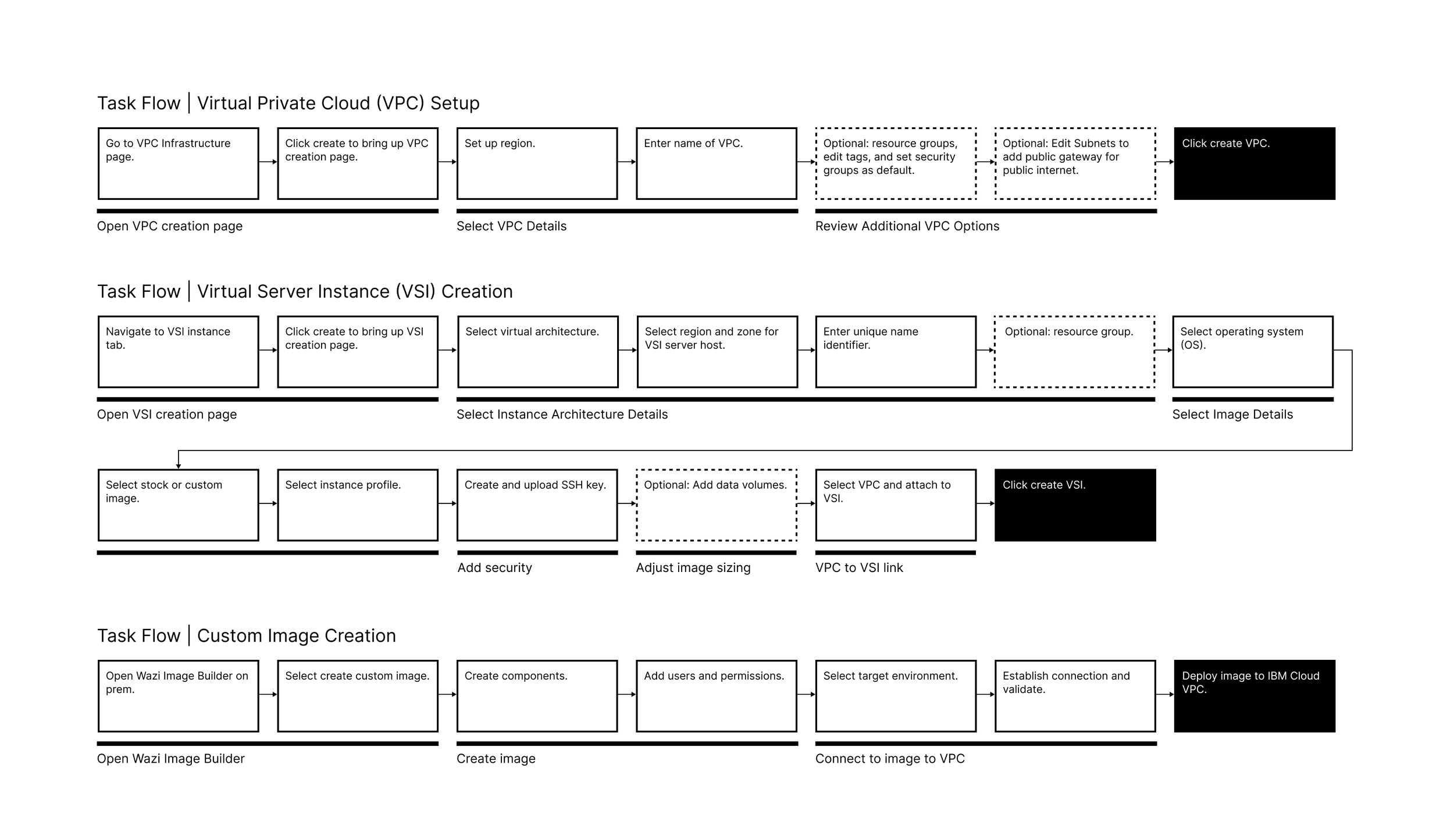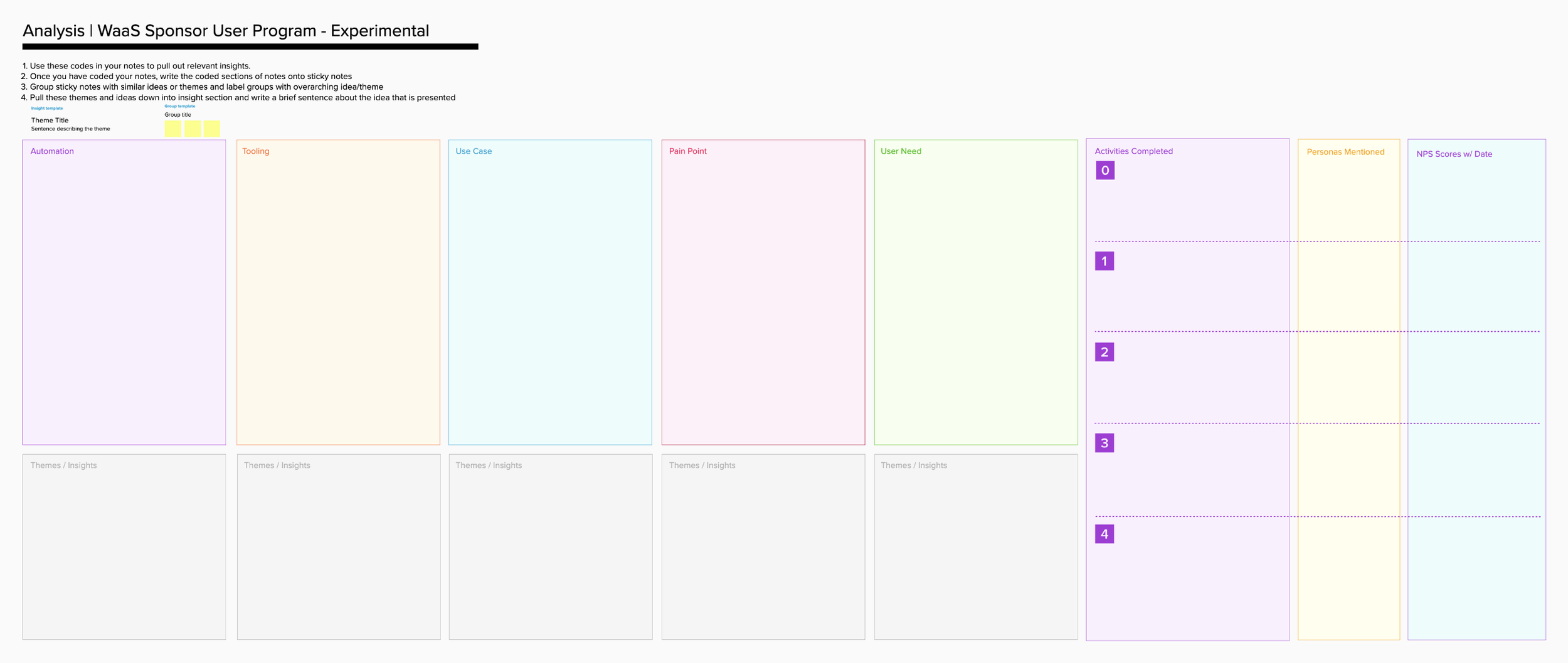Case Study: Wazi as a Service for IBM Cloud
Leading the pre-launch sponsor user program
Overview
Product Summary
Wazi as a Service is a brand-new service offering that provides DevOps Engineers with the ability to log into IBM Cloud and create a z/OS virtual server instance within their virtual private cloud. Unlike other virtual server instances that mimic Z hardware, Wazi as a Service instances run on real Z hardware, providing users with better performance and faster speed to market. Wazi as a Service is a one-of-a-kind cloud-based development and testing tool.
Business Objectives
Modernize DevOps Tooling: Contributed to the development of Wazi as a Service, a cloud-based testing tool designed to streamline the development lifecycle for enterprise clients, aligning with IBM's core business strategies.
Enhance Development Efficiency: Delivered a modernized solution through Wazi as a Service, equipping enterprises with advanced DevOps testing capabilities to improve operational efficiency and accelerate time-to-market.
Result
The sponsor user program was acknowledged as a complete success by the executive leadership team. During the 6-month sponsor user program, we had a total of 22 different companies participating as sponsor users and held over 46 user sessions. The research data collected helped identify key pain points in the current experience while providing solutions to emerging issues prior to launch.
Tools
Figma, Mural, SurveyMonkey, Jira, Photoshop
Role
I am the UX Designer and Strategist Lead for Wazi as a Service. It was my responsibility to lead the entire sponsor user program initiative, which included developing a research plan, facilitating and managing user sessions, synthesizing research data, and improving the overall user experience.
Research
Initial Research
The Wazi as a Service Sponsor User Program was a unique and challenging opportunity to lead at IBM. With 22 different companies participating in the program, each with teams of 2-6 people, it was important that everything was thoroughly planned and coordinated to ensure we ended up with as rich of data as possible to improve the experience for our future users. To do this I developed a research plan and settled on three primary research methods that included user interviews, user sessions, and UX journals to collect user experience data.
User Interviews | With such a healthy sample of users participating in the sponsor user program, we worked to develop a user interview script that helped us better understand their current experience, their needs and expectations for this type of service offering, and the pain points they were looking to resolve with our help.
User Sessions | Although all of our sponsor users were excited to get started and begin testing out our new service offering, some teams had limited experience with cloud-based products while others were in the middle of adjusting their workflows to incorporate more cloud and automated services. This led us to make our user sessions more fluid and targeted to each unique user’s perspective, these sessions could take the form of a design thinking activity on Mural to map out the current experience, a guided usability testing session, or even a discussion.
UX Journals | Since we had a large number of sponsor users and a limited number of design team members, we were limited on how many user sessions we could hold each week. To ensure we were capturing the user’s pain points and user needs in real-time, we provided them with an easy-to-complete UX journal that they were required to complete once a week and encouraged them to complete following each use of the service.
Throughout the duration of the sponsor user program, it was my responsibility to present recent findings during our weekly cross-functional team meetings. I also developed several playback decks that provided synthesized research data to stakeholders that included recommendations to improve the current experience of the service offering, as well as work with the Product Manager and Engineers to fit those recommendations into our planning iterations.
Personas
There are several personas of interest for Wazi as a Service, especially with the application development cycle involving a variety of hand-offs. However, for this research initiative, our main focus was on Deb the Application Developer and Rohan the DevOps Engineer, the primary users of the service offering.
Rohan the DevOps Engineer
Rohan, a member of the product team works closely with the Cloud Admin and Application Developer, his primary focus is maintaining, buildings, and monitoring infrastructure.
Deb the Application Developer
Deb is a member of the product team, her responsibilities involve several parts of the development process including planning, coding, building, provisioning, deploying, and testing the product.
Process
Evaluative Task Flows
Throughout the sponsor user program, there were several task flows we wanted to evaluate and measure from a user experience perspective. Some of these task flows included setting up their virtual private cloud, creating their virtual server instance, and creating a custom image.
Task Flow Findings
Although the majority of the sponsor users were able to successfully complete all three tasks, many needed the support of our team to do so. The cause of these difficulties was found to be due to two major reasons, documentation and experience. At the time, the current documentation for Wazi as a Service was found in two separate locations, IBM Cloud and IBM Documentation, due to this fragmentation users often became lost when moving back and forth between the two sources. Their previous experience also impacted their ability to work independently, as they were not yet familiar with the IBM Cloud platform and did not have the proper image management procedures in place to avoid having oversized inflated images.
To resolve these two issues, we worked with the content design team to centralize the documentation in one place and more effectively linked additional documentation when a user needed to navigate back and forth between separate documentation sources. We then worked with the engineering team to create additional volumes that users could use when creating their custom images to accommodate larger image sizes, while also guiding them on how to best create images that were as small as possible.
Colour Coding Analysis
During the research plan phase of the sponsor user program, we identified five categories that we would use to colour code and synthesize research data no matter the research method used. These categories included Automation, Tooling, Use Cases, Pain Points, and User Needs. We then developed an easy-to-use tracker on Mural that we would place stickies under each category when a piece of data showed up that fit underneath a particular bucket. This synthesis method allowed us to document qualitative findings easily while also allowing us to measure results quantitatively as certain comments or information kept coming up from different users. A big win for this method was identifying a primary use case for the service offering that was not originally one of our main focuses until seeing it was needed and expected by a number of our users.
Universal Experiences
In addition to evaluating the Use phase of the experience, it was imperative that we also evaluate the other phases of the Universal Experiences. These phases include Discover, Learn, Try, Buy, Get Started, Use, Get Help, Expand, and End Use.
This evaluative method helped us quickly identify and flag potential issues users may face following the June 30th launch of the service offering. The main issues found were in the Discover, Learn, and Try phases, some examples are included below.
Discover | The service offering wasn’t easily searchable in IBM Cloud or in general search, meaning users could only find it if they were informed of it first.
Learn | Users found it challenging to find documentation that helped them better understand Wazi as a Service and its use cases, prior to becoming active users.
Try | There was no current free trial available for users and there was no alternative method available for users to decide if it was the right decision for them or not.
UI Design Updates
The primary screen of the Wazi as a Service experience is the Virtual Server creation screen. In this screen, users can select the type of virtual server instance they want, where they want to host it, and select additional components they want to be included. The user research data gathered during the sponsor user program helped us identify key areas of the user interface that could be improved upon to benefit the user’s experience when navigating the page.
To streamline the experience, we provided users with the ability to quickly select the architecture they want to build their virtual server instance with and have the page options adjusted based on that selection.
We customized the calculator selection to visually clarify to users which type of instance and image they selected to avoid errors when checking out.
3. We enabled IBM z/OS to be selected directly from the operating system section, as well as the ability to select either the newest version of the stock image or to import their own custom image. We also created an external custom image creation tool that would allow users to easily create their custom images and make them selectable in this section.
4. Lastly, we used the collected research data to identify the most relevant information to display when selecting the right memory profile for their virtual server instance.
Impact
The sponsor user program for Wazi as a Service was a success and lead to the identification of issues, gaps, and needed improvements that would have impacted the user experience if not addressed prior to the launch of the service. The research data collected was also used to help validate and update personas, while also proving useful for other products that were looking to integrate with Wazi as a Service. Following the sponsor user program, Wazi as a Service launched smoothly and we continue to have a great relationship with the sponsor user program participants as they continue to help us improve the experience of the service today. Several have also offered to join the other product I lead that is currently pre-launch.








